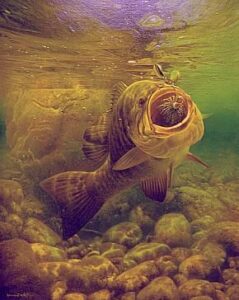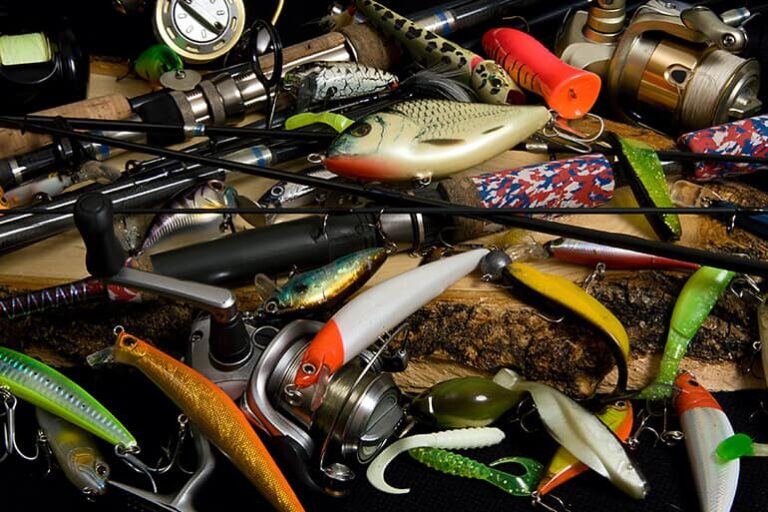Smallmouth vs Largemouth Bass: Habitat, Diet, Behavior, and More
Smallmouth and largemouth bass are similar, but have unique behavior, diet, and tendencies that change how you need to fish for them.
I think that smallmouth are actually more fun to catch and fish for. They tend to fight harder and be more beautiful fish in my opinion.
But largemouth are much more wide spread and available at almost every body of water in the country.
Smallmouth vs Largemouth Bass Apperance
These two species are very easy to tell apart and really can’t be mistaken.
Smallmouth Physical Characteristics
- Size Range and Weight: Smallmouth Bass are typically smaller than Largemouth bass. On average, they range from 12 to 16 inches in length and weigh between 1 to 4 pounds. However, in certain optimal habitats with abundant food sources, they can grow larger. Occasionally reaching lengths of 20 inches or more and weighing up to 5 or 6 pounds.
- Coloration and Markings: Smallmouth body coloration varies depending on their environment, but they usually feature a base color of olive to brownish-green on their backs, blending into a lighter, golden hue on their sides. The most distinctive characteristic is a series of dark, vertical bars on their sides, which are more pronounced in younger fish but tend to fade as they mature.
- Fin and Mouth Structure: Smallmouth Bass have a unique fin and mouth structure. Their dorsal fin, the one along their back, is divided into two distinct parts, the spiny and soft portions. The spiny part of the dorsal fin typically has between 8 to 13 spines, while the soft part consists of 10 to 13 rays.
Largemouth Characteristics
- Size Range and Weight: On average, largemouth bass measure between 15 to 20 inches in length and weigh about 2 to 5 pounds. However, in prime conditions with an abundant food supply, they can reach impressive sizes, exceeding 20 inches and weighing over 10 pounds, with some exceptional individuals even tipping the scales at 20 pounds or more.
- Coloration and Markings: Their upper bodies sport shades of dark green to olive, gradually transitioning to a lighter green or yellow on their sides. Along their flanks, you’ll find a distinct horizontal stripe that runs from the gills to the tail, often lighter in color than the rest of their body. They also have a mottled pattern along their back and sides, resembling a camouflage design to aid in ambushing prey.
- Fin and Mouth Structure: Largemouth Bass have a large mouth that extends beyond the eye’s midpoint, which is one of their primary identifying features. Additionally, their dorsal fin, the one located on their back, is continuous rather than separated into two distinct parts like that of the Smallmouth Bass. The dorsal fin typically has between 9 to 12 spines and 11 to 13 rays, contributing to their exceptional maneuverability in their preferred habitat.
Background and Habitat
Smallmouth and largemouth bass have a bit different habitats. Although they can live in the same areas, their ideal habitats are different and unique.
Smallmouth Bass Habitat
Smallmouth bass love rivers and running water. Rivers, streams, creeks, and big lakes that have lots of water are the prime locations for smallmouths.
There are plenty of ponds around the US that have smallmouth in them, but rivers and large lakes are the preferred waters of smallies.
Within these bodies of water, smallmouths tend to hold to rocks and wood. They don’t seem to hang around weeds and grass as much as largemouths.
Smallies also prefer a bit colder water. So they will hold to a bit deeper water, and be found much more in northern states.
Largemouth Bass Habitat
Largemouth bass are more densely populated in still bodies of water. Every small pond or lake will hold lots of largemouth bass.
Largemouths also live in river systems, but will be outnumbered by smallmouth bass in moving water systems.
Within the bodies of water that largemouth bass live, they will hold to really any structure where there is warm water.
Grass, rocks, wood, docks, or whatever other structure is around.
Largemouths can thrive in very warm water. The southern states are your best be for giant largemouths.
Feeding Behavior and Diet
Discover the captivating world of bass feeding behavior and diet.
Join us as we delve into the culinary preferences and hunting techniques of Smallmouth and Largemouth Bass, uncovering the secrets that make them skilled predators in freshwater ecosystems.
Smallmouth
Smallmouth Bass are voracious and opportunistic feeders, displaying a diverse diet that evolves throughout their life stages.
As skilled ambush predators, they have adapted their feeding behaviors to suit their preferred habitats and the availability of prey items.
Here’s an insight into their intriguing culinary preferences:
- Diet Composition: Smallmouth Bass are primarily carnivorous, with a diet mainly comprising aquatic insects, crayfish, small fish, and occasionally, other invertebrates. Their diet may vary depending on the season, water temperature, and the abundance of prey species in their habitat.
- Hunting Techniques: Smallmouth Bass are agile and stealthy predators. They often lie in wait near rocky structures, submerged logs, or undercuts along riverbanks, patiently watching for potential meals. Once a suitable prey item comes into their range, they use rapid bursts of speed to ambush and capture it.
- Feeding Habits by Season: During spring and early summer, Smallmouth Bass tend to be more active, aggressively feeding as they prepare for the breeding season. They often target smaller fish and crayfish during this time. As summer progresses, their feeding activity may slow down in response to rising water temperatures, and they may switch to smaller prey like insects.
- Prey Size Preference: Smallmouth Bass exhibit selectivity in their prey choices. They tend to target prey that is proportionate to their own size, and while they may consume smaller fish, they are not as prone to attempting to eat prey significantly larger than themselves, unlike Largemouth Bass.
Largemouth
Largemouth Bass, as one of the apex predators in freshwater ecosystems, possess a voracious appetite and a wide-ranging diet.
Their feeding behavior is influenced by their preferred habitat and the availability of prey items.
Let’s dive into the culinary preferences and hunting strategies of these formidable aquatic hunters:
- Diet Composition: Largemouth Bass are opportunistic carnivores, and their diet consists of a variety of prey items. Their primary food sources include small fish, crayfish, frogs, insects, and even small mammals and birds when the opportunity arises. This adaptability allows them to thrive in various environments.
- Hunting Techniques: Largemouth Bass are ambush predators that capitalize on their camouflage and explosive bursts of speed to surprise their prey. They often lurk in submerged vegetation, near structures, or under overhanging branches, patiently waiting for unsuspecting prey to venture close enough to strike.
- Feeding Habits by Season: Largemouth Bass exhibit seasonal changes in their feeding habits. During spring, they become more active and aggressively feed to build up energy for spawning. In warmer months, they tend to be more selective in their feeding due to higher water temperatures, focusing on larger prey like fish and frogs.
- Prey Size Preference: Largemouth Bass are notorious for their “big appetite, big prey” mentality. They have been known to attack and consume prey significantly larger than themselves, including fish nearly half their size. This characteristic has contributed to their reputation as formidable predators.
Fishing Techniques for Each Species
Finesse fishing techniques tend to work better for smallmouth bass, and power fishing tends to work better for largemouth bass.
Smallmouths also love crawfish. Crawfish imitations are my go to way to catch bronze backs.
I usually will use shad or bluegill imitations for largemouth most months of the year.
Best Lures for Each Bass
Best Lure for Smallmouth Bass
- Tube Baits: Tube baits are highly effective for Smallmouth Bass, mimicking crayfish or other small prey items that are a staple in their diet. Rig them with an internal jig head or fish them weightless for a natural action that entices strikes.
- Crankbaits: Crankbaits that imitate baitfish are excellent choices when targeting Smallmouth Bass in deeper waters or along rocky structures. Opt for medium-diving or lipless crankbaits to cover different water depths.
- Spinnerbaits: Spinnerbaits with a smaller profile and natural color patterns can work wonders in enticing Smallmouth Bass. Retrieve them at various speeds to determine the most enticing presentation.
Best Lures for Largemouth Bass
- Soft Plastic Worms: Soft plastic worms, especially in natural colors like green pumpkin or watermelon, are go-to lures for Largemouth Bass. Texas or Carolina rig them to navigate through weeds and other cover.
- Jigs: Jigs are versatile and effective for Largemouth Bass, particularly when flipping or pitching them into heavy cover. Choose jigs with weed guards to avoid snagging in dense vegetation.
- Topwater Lures: Largemouth Bass are known for their explosive strikes on topwater lures. Popper-style baits, buzzbaits, and frog imitations are great choices, especially in early morning or late evening when the bass are most active near the surface.
Conclusion
From exploring the distinct traits of Smallmouth and Largemouth Bass to mastering the art of angling with the best techniques and lures, we’ve truly uncovered the secrets of these fascinating freshwater predators.
Remember, bass fishing is more than just a sport; it’s an experience that connects us with nature and fuels our passion for the great outdoors.
Whether you’re a seasoned angler or just starting, there’s always something new to learn and discover on every fishing trip.
So, next time you head out to the water, armed with your knowledge of Smallmouth and Largemouth Bass, take a moment to appreciate the beauty of your surroundings, the thrill of the hunt, and the joy of landing that prized catch.











